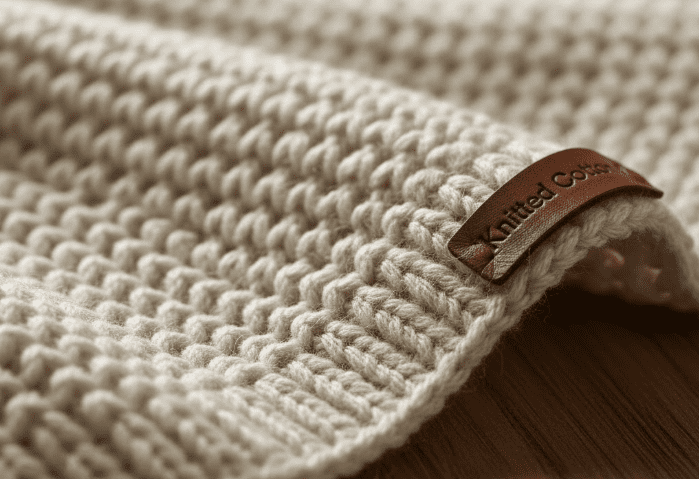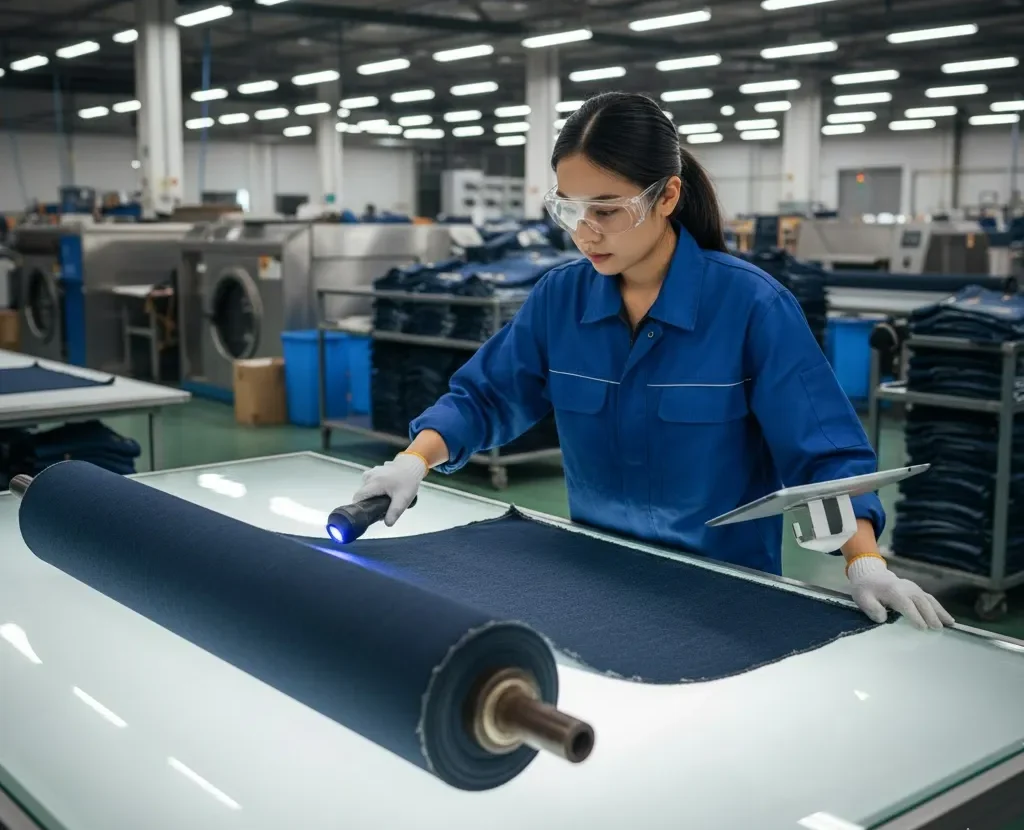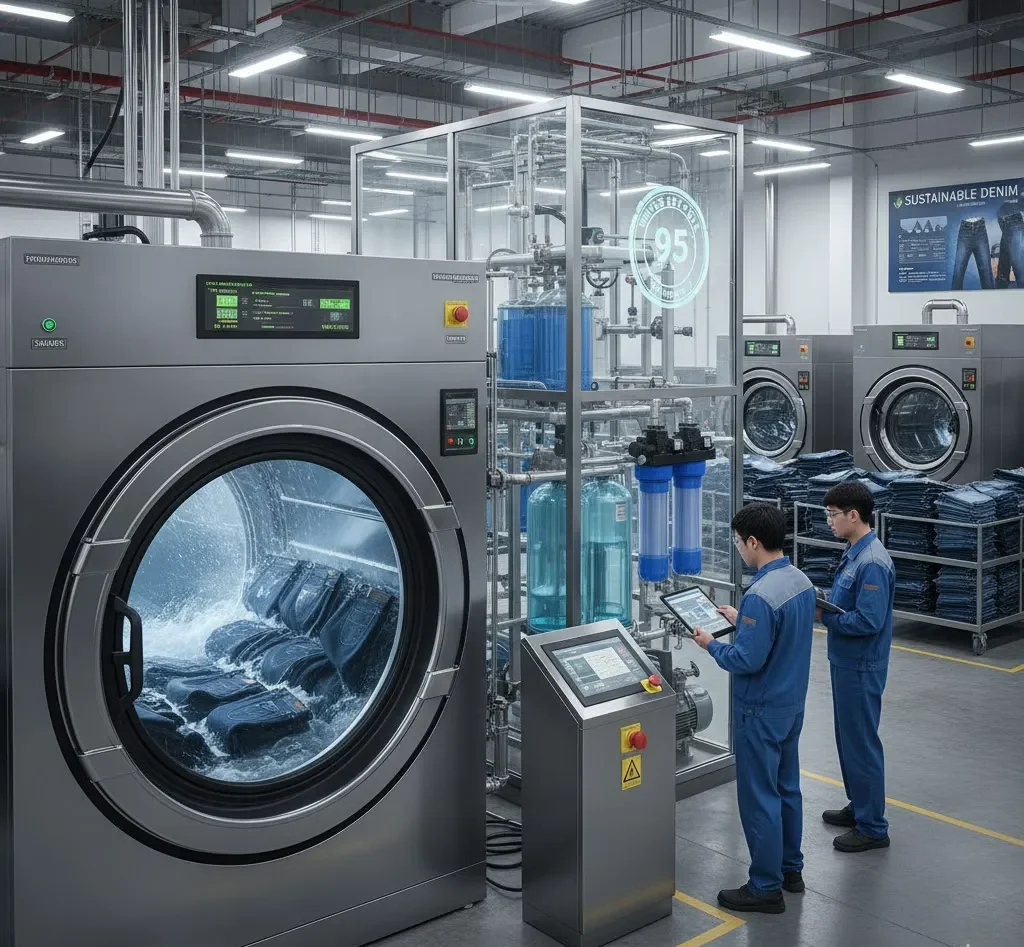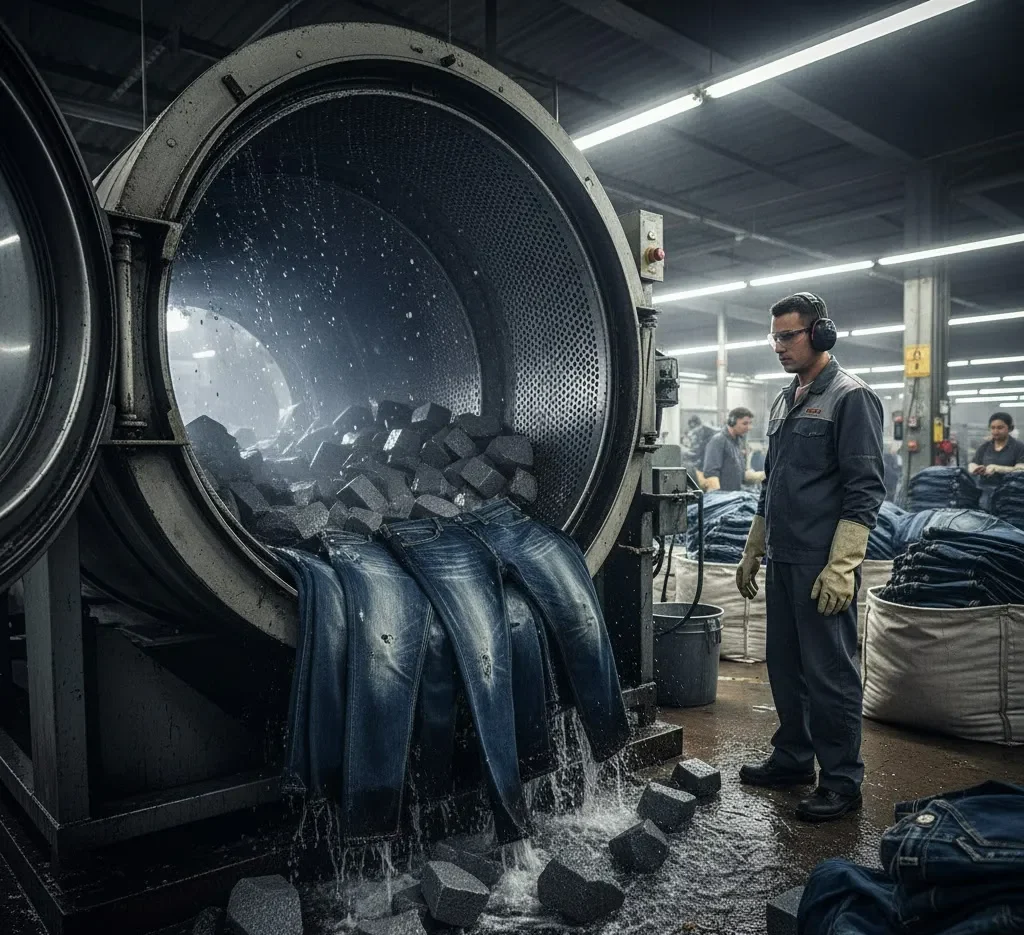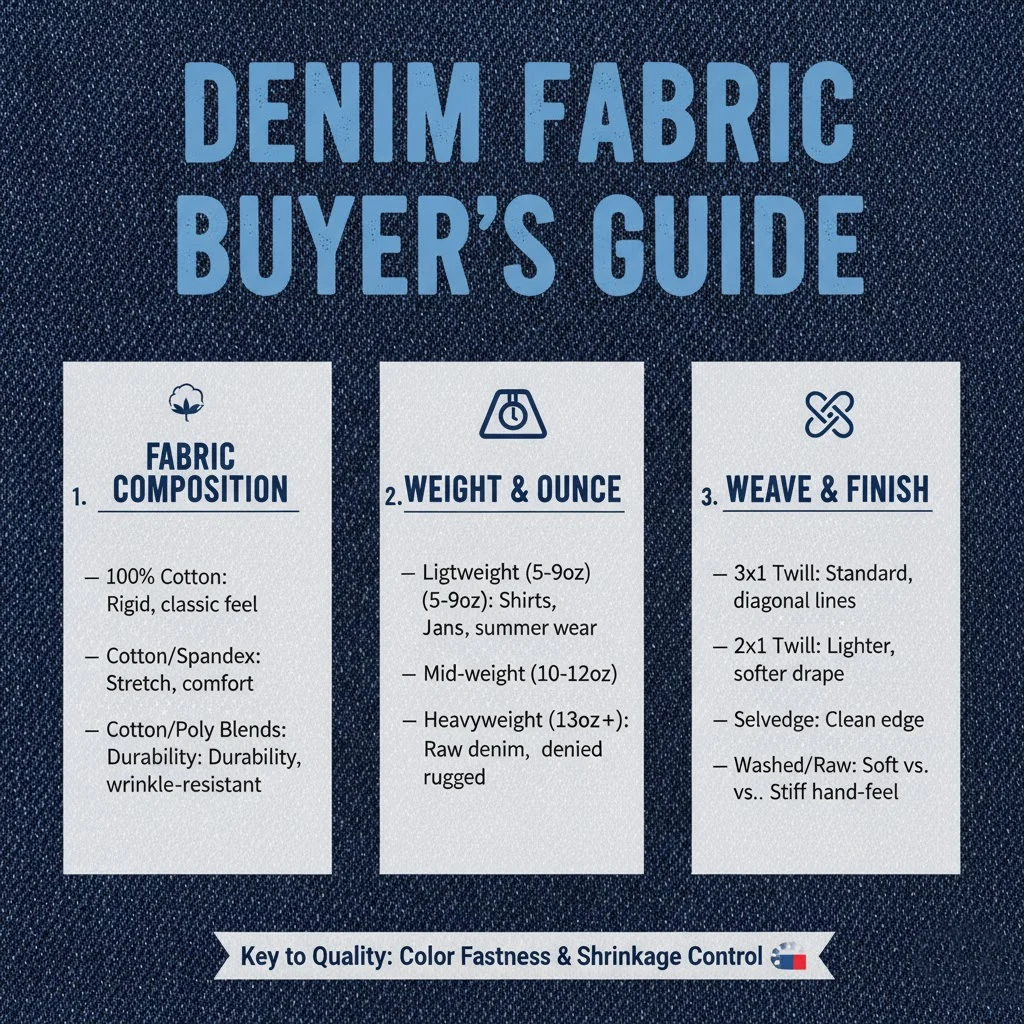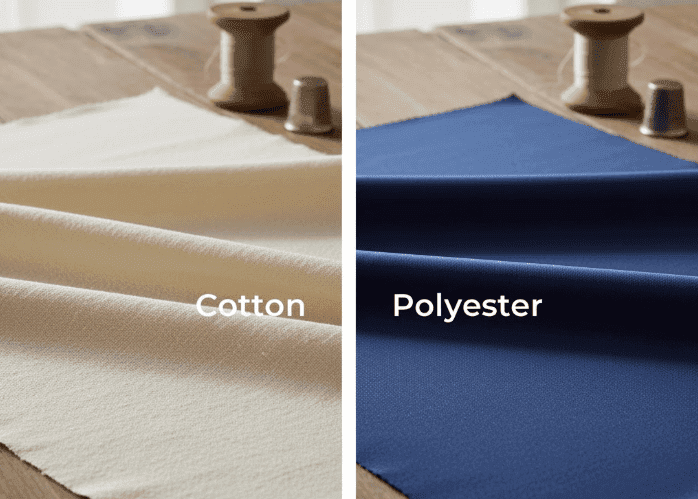Introduction
You feel it in your favorite t-shirt, your coziest sweatshirt, and your most comfortable loungewear. That signature softness and stretch are the work of knitted cotton fabric.
But what exactly is it? As textile manufacturing experts, we believe a deep understanding of a material is the foundation of creating great products. This guide will demystify what is knitted cotton, exploring its unique construction, its key characteristics, and the common types every designer and buyer must know.
What Is Knitted Cotton?
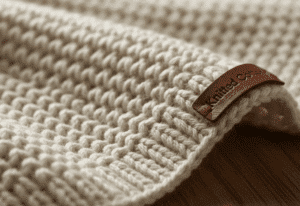
Knitted cotton fabric is characterized by its unique structure: yarns are interwoven into loops. This looping construction gives knitted cotton its signature stretchiness, as well as its inherent softness and flexibility.
Unlike woven cotton, which is created by interlacing threads horizontally and vertically in a crisscross pattern…
To put it simply, knitted cotton’s individual loops hook into one another, resulting in a fabric that offers natural stretch, a soft feel, and excellent flexibility.
How Is Knitted Cotton Made?
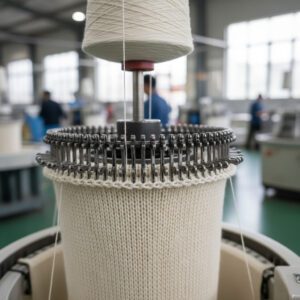
The secret to knitted cotton lies in its construction. Unlike woven fabrics which are made on a loom with two sets of straight threads (warp and weft), knitted fabric is created with a single yarn or a set of yarns that are looped together.
Think of it this way:
A woven fabric is like a rigid brick wall, with threads laid in a tight, stable grid.
A knitted fabric is like flexible chainmail armor, where a single thread is formed into a series of interlocking loops.
This looping structure is the source of the fabric’s inherent ability to stretch, even without any elastic fibers.
For a more technical look at knit mechanics, you can explore academic resources like those from North Carolina State University’s Wilson College of Textiles.
Knitted Cotton vs. Woven Cotton
Understanding this core difference is fundamental for any apparel professional.
| Feature | Knitted Cotton Fabric | Woven Cotton Fabric (e.g., Poplin) |
|---|---|---|
| Structure | Interlocking loops of yarn | Criss-cross grid of warp & weft yarns |
| Stretch | Naturally stretchy and flexible | Rigid and stable, no natural stretch |
| Wrinkle Resistance | Good; the loops tend to recover | Prone to wrinkling and creasing |
| Breathability | Generally very breathable | Varies by weave tightness |
| Best For | T-shirts, sweatshirts, sportswear, leggings | Dress shirts, trousers, structured dresses |
The Pros and Cons of Knitted Cotton
This unique structure results in a distinct set of advantages and disadvantages.
Advantages
- ✓ Exceptional Comfort & Softness: The loose, looped structure creates a fabric that is inherently softer and more pliable than most wovens.
- ✓ Inherent Stretch & Flexibility: It moves with the body, providing excellent freedom of movement without the need for elastane (though it is often added for enhanced recovery).
- ✓ Good Wrinkle Resistance: The loops in the fabric are less prone to holding sharp creases compared to the rigid grid of a woven fabric.
- ✓ Easy Care: Most cotton knits are machine washable and generally easy to maintain.
Disadvantages
- ✗ Prone to Pilling: The same loose structure that provides softness means the fibers can be more susceptible to rubbing and forming small balls of fiber (pills) on the surface.
- Tips:Quality can be measured by standards like ASTM D3512 for Pilling Resistance.
- ✗ Can Shrink or Stretch Out: If not cared for properly (e.g., washed in hot water or hung to dry), the loops can distort, leading to shrinkage or stretching.
- ✗ Can Snag: The loops can be snagged by sharp objects, potentially creating a pull or a hole in the fabric.
The 5 Major Types of Knitted Cotton: A Comprehensive Analysis
Not all knits are created equal. Here are the five essential types of cotton knits you will encounter.
What is cotton jersey knit?
This is the most common type of knit fabric. It is a single knit, meaning it’s made with one set of needles. You can identify it by its distinct front and back: the face is smooth with fine vertical ribs, while the back has a more textured, looped appearance. It’s lightweight, breathable, and has a fluid drape, but its edges tend to curl when cut.
What is double knit cotton?
Interlock is the perfect example. It’s made by interlocking two layers of single jersey fabric together. It’s like two jersey fabrics fused back-to-back, so the smooth surface is on both the front and the back. It is thicker, heavier, and more stable than single jersey. It doesn’t curl at the edges and offers a more premium, substantial feel, making it ideal for high-quality polo shirts and baby clothes.
What is cotton piqué knit?
Piqué (pronounced pee-kay) is a type of knit that creates a textured, three-dimensional pattern, typically a waffle, honeycomb, or bird’s-eye shape. This texture creates small pockets that allow air to circulate, making it exceptionally breathable. Its combination of texture, breathability, and structure has made it the undisputed fabric of choice for classic polo shirts.
What is French Terry fabric?
This is a type of weft-knit fabric that is smooth on the face side and has soft, absorbent loops on the back side. It is a mid-weight fabric, heavier than a t-shirt but lighter than a traditional fleece sweatshirt. Its looped back is excellent at wicking moisture, making it a popular choice for comfortable loungewear, shorts, and light sweatshirts.
What is rib knit cotton?
A rib knit is created by alternating rows of knit and purl stitches, forming visible vertical ribs or “wales.” This structure gives it an incredible amount of crosswise stretch and recovery—much more than jersey. You’ll find cotton knit ribbing fabric used for the cuffs, collars, and hems of sweatshirts and jackets, as well as for entire garments like form-fitting tank tops and bodysuits.
How to Washing for Knitted Cotton Garments? (Without Shrinking)
Proper care is essential to prevent shrinkage and distortion.

Tools & Materials Needed:
- Mild, color-safe liquid detergent
- Mesh laundry bags
- A flat surface (like a clean towel or a mesh drying rack)
The 4-Step Process:
1. Preparation
Turn garments inside out to protect the surface from abrasion and pilling. Place delicate knits in a mesh laundry bag.
2. Washing
Always use cold water (30°C / 86°F or below) and select the ‘Delicate’ or ‘Gentle’ cycle on your machine. This minimizes both shrinkage and stress on the fabric’s loops.
3. Squeeze Out Water (Crucial Step)
Note: Never hang a wet knitted garment to dry.
Gently roll the garment in a clean towel to squeeze out excess water. The weight of the water will pull on the loops and stretch the garment out of shape if hung.
4. Lay Flat to Dry
Lay the damp garment flat on a clean, dry towel or a mesh drying rack away from direct heat or sunlight. Reshape it to its original dimensions as it dries.
(For more general washing advice, see our complete Pure Cotton Care Guide.)
Conclusion
In essence, what is knitted cotton fabric? It is the architecture of comfort. Its unique, flexible structure of interlocking loops gives it the stretch, softness, and wrinkle resistance that has made it the foundation of modern casual and athletic apparel. From the simple Jersey of a t-shirt to the textured Piqué of a polo, understanding these different knit types empowers you to make smarter choices as a designer, buyer, or consumer. By selecting the right knit and caring for it properly, you are choosing a fabric built for a life of comfort and movement.
Ready to Apply This Knowledge?
For a deeper dive into selecting the right materials, or if you have specific questions for your next project, our team is here to help.
Knitted Cotton FAQ
Is knitted fabric 100% cotton?
Not always. “Knit” refers to the fabric construction, not the fiber content. While cotton knits are extremely popular, you can also find knits made from polyester, rayon, wool, or blends. Always check the label for the exact fiber composition.
Does knitted cotton shrink?
Yes, like most cotton fabrics, knits are susceptible to shrinkage, especially from heat. The looped structure can contract when exposed to hot water or a high-heat dryer. Following the cold wash and lay-flat-to-dry care instructions is the best way to prevent this.
Is knitted cotton good for hot weather?
It depends on the type and weight. A lightweight cotton jersey knit or a breathable cotton piqué knit are excellent choices for summer as they allow for good airflow. However, a heavyweight knit like French Terry or Fleece would be too warm.
Is knitted cotton sustainable?
The sustainability of knitted cotton depends on the farming and manufacturing processes. Choosing knits made from certified organic cotton (GOTS) or from producers who are part of the Better Cotton Initiative (BCI) ensures that the cotton was grown with more environmentally and socially responsible practices.

